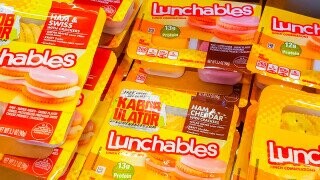Lunchables Are Trash Food, But The Nostalgia Is Real

Celebrated by parents for saving them precious minutes of lunch prep and by kids as a fun food, Lunchables are composed of anything from a gas station charcuterie board to a DIY pizza that is legally considered a hate crime in Italy. At one point, in an effort to make them healthier, fruit had been experimented with, but they couldn't get it to stay fresh in the disposable tray.
First produced in 1985 as a result of a national bologna surplus, the creation has long been a red flag in the world of nutrition. This processed disaster of a meal is in the running for food most likely to survive the ruins of mass extinction. But how did the Lunchable thrive for the last 36 years, and what are the skeletons lying in its closet?

Don't Miss
Originally conceived with an adult audience in mind (crack really took off in the '80s), the company discovered that kids were their golden target. According to the Atlantic, "the creators of Lunchables aimed younger when they discovered in market research how much fun kids had assembling their meals." Drawing inspiration from TV dinners, kids enjoyed the compartments Lunchables offered, while envy reigned in the cafeteria toward the kid who brought one that day. Your cool factor somehow grew if you were seen with this biohazard of a lunch.

It's no fun discovering truths about something you find innocently nostalgic, such as the timeless (because you'll expire before it does) Lunchable. However, some factors have become hard to ignore, for one: the inventor of the Lunchable doesn't even allow his own children to eat them. Don't be fooled by the quaint yellow box that is, according to the Healthy Home Economist, "the best known example of a modern day lab lunch." Secondly, 42 versions of the Lunchable exist, yet only five have been approved to be advertised.
See, Kraft Foods entered the Children's Food and Beverage Advertising Initiative, which has food companies agree only to promote products to children that meet a certain nutritional requirement. But to be fair, Oscar Mayer does clarify that Lunchables are meant to be a treat, not an everyday habit. If given as a reward every once in a while, kids will most likely be okay, and the world will keep turning (and kids' hearts still pumping).
Still, after being deemed a "nutritional disaster" in the 90s by a pediatric cardiologist at the Chicago Children's Memorial Hospital, an Oscar Mayer spokesperson retorted, "This is not some big, corporate plot to fatten up kids. This is what kids want, there are very few kids out there who will eat rice cakes and tofu." Why are rice cakes and tofu the alternative? No one knows. Regardless, the evolution of the Lunchable has certainly been building for years …
Though for many kids, the building was the main selling point. Lunchables gave children independence, or at least the illusion of it, to stack their food however the hell they wanted to.
For more of Oona’s sarcasm and attempted wit, visit her website oonaoffthecuff.com.
Top Image: TonelsonProductions / Shutterstock